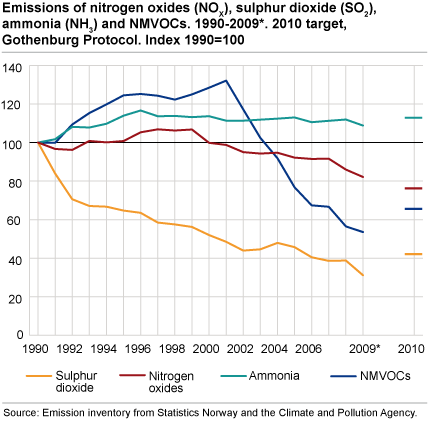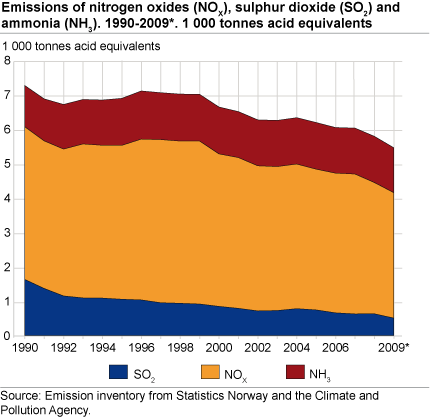Content
Published:
This is an archived release.
Continued decrease in emissions of acidifying substances
Emissions of all acidifying substances have decreased from 2008 to 2009, and it seems likely that the emission obligations for 2010 will be fulfilled, with a possible exception for NOX. The emission reduction is partly caused by lower metal production, due to the financial crisis.
This is indicated in preliminary figures in the Norwegian emission inventory, which is compiled by Statistics Norway in collaboration with the Climate and Pollution Agency.
| Gas | Emissions 1990 | Emissions 2009* | Emission ceiling 2010 | Necessary reduction 2009-2010 | Harmful effects | ||||||||||||||||||||||||||||||||||||||||||||||||||||||||||||||||||||||||||
|---|---|---|---|---|---|---|---|---|---|---|---|---|---|---|---|---|---|---|---|---|---|---|---|---|---|---|---|---|---|---|---|---|---|---|---|---|---|---|---|---|---|---|---|---|---|---|---|---|---|---|---|---|---|---|---|---|---|---|---|---|---|---|---|---|---|---|---|---|---|---|---|---|---|---|---|---|---|---|---|
| Nitrogen oxides (NOX) | 204 | 167 | 156 | 11 500 tonnes (7 per cent) | Increase the risk of respiratory disease (particularly NO2). Contribute to acidification, corrosion and formation of ground-level ozone. | ||||||||||||||||||||||||||||||||||||||||||||||||||||||||||||||||||||||||||
| Sulphur dioxide (SO2) | 52 | 16 | 22 | Emission ceiling reached at the moment | Increases the risk of respiratory complaints. Acidifies soil and water and causes corrosion. | ||||||||||||||||||||||||||||||||||||||||||||||||||||||||||||||||||||||||||
| Ammonia (NH3) | 20 | 22 | 23 | Emission ceiling reached at the moment | Contributes to acidification of water and soils. | ||||||||||||||||||||||||||||||||||||||||||||||||||||||||||||||||||||||||||
| NMVOCs | 300 | 161 | 195 | Emission ceiling reached at the moment | May include carcinogenic substances. Contribute to formation of ground-level ozone. | ||||||||||||||||||||||||||||||||||||||||||||||||||||||||||||||||||||||||||
| CO | 868 | 365 | - | No quantified emission ceiling | Increases risk of heart problems in people with cardiovascular diseases. | ||||||||||||||||||||||||||||||||||||||||||||||||||||||||||||||||||||||||||
| Source: Emission inventory from Statistics Norway and the Climate and Pollution Agency. |
A further reduction in NOx emissions is needed
Norwegian emissions of NOx(nitrogen oxides) amounted to 167 500 tonnes in 2009. This is approximately 7 800 tonnes, or 4 per cent, less than in 2008. To fulfil the emission obligation in the Gothenburg protocol, it is necessary to reduce the emissions by a further 11 500 tonnes in 2010.
Domestic sea transport and fishing caused 39 per cent of the total Norwegian NOx emissions in 2009. Stationary combustion in oil and gas related activities contributed with 23 per cent, and road traffic with 17 per cent. Several factors contributed to the decrease from 2008. An important cause, which might be preliminary, is lower metal production, due to the financial crisis. This led to an emission reduction for all gases. Another cause is reduced stationary combustion of natural gas in oil and gas activities on the Norwegian continental shelf. Improved technology has led to lower NOx emissions from road traffic.
Lower emissions of acidifying substances
Total emissions of acidifying substances, converted to acid equivalents, amounted to 5 500 tonnes in 2009. NOx constituted 67 per cent of this, and NH3 and SO224 and 9 per cent respectively. Emissions of acidifying substances have been reduced by 25 per cent from 1990 and 6 per cent from 2008. Taking into account the acidifying effect of the different gases, NOx is responsible for more than half of the total reduction in acidifying substances in Norway from 2008.
Preliminary figuresThe figures for 2009 presented in this article are preliminary, but still relatively reliable. This particularly applies to total emission figures. The sales statistics for petroleum products, based on reports from the oil companies on sales of oil products to different consumer groups, form the basis for calculating combustion emissions. Possible errors and insecurities in these statistics will have a direct effect on levels and trends in the emission statistics. Detailed tables for 2009, including distributions between source and industry, will not be published until February 2011. About the emission inventoryRead more about acid equivalents and international obligations . Read more about the state of the environment in Norway . |
See also emission figures for greenhouse gases .
Tables:
- Table 1 Emissions to air by source. 1990
- Table 2 Emissions to air by source. 2007
- Table 3 Emissions to air by source. 2008*
- Table 4 Emissions to air of NOX, SO2, NH3, NMVOCs and CO. 1973-2009*
- Table 5 Emissions to air of SO2, NOX, NH3, NMVOCs and CO by industry. 2008. Tonnes
- Table 6 Emissions to air of SO2, NOX, NH3, NMVOCs and CO by industry. 2009. Tonnes
The statistics is published with Emissions to air.
Contact
-
Statistics Norway's Information Centre
E-mail: informasjon@ssb.no
tel.: (+47) 21 09 46 42


